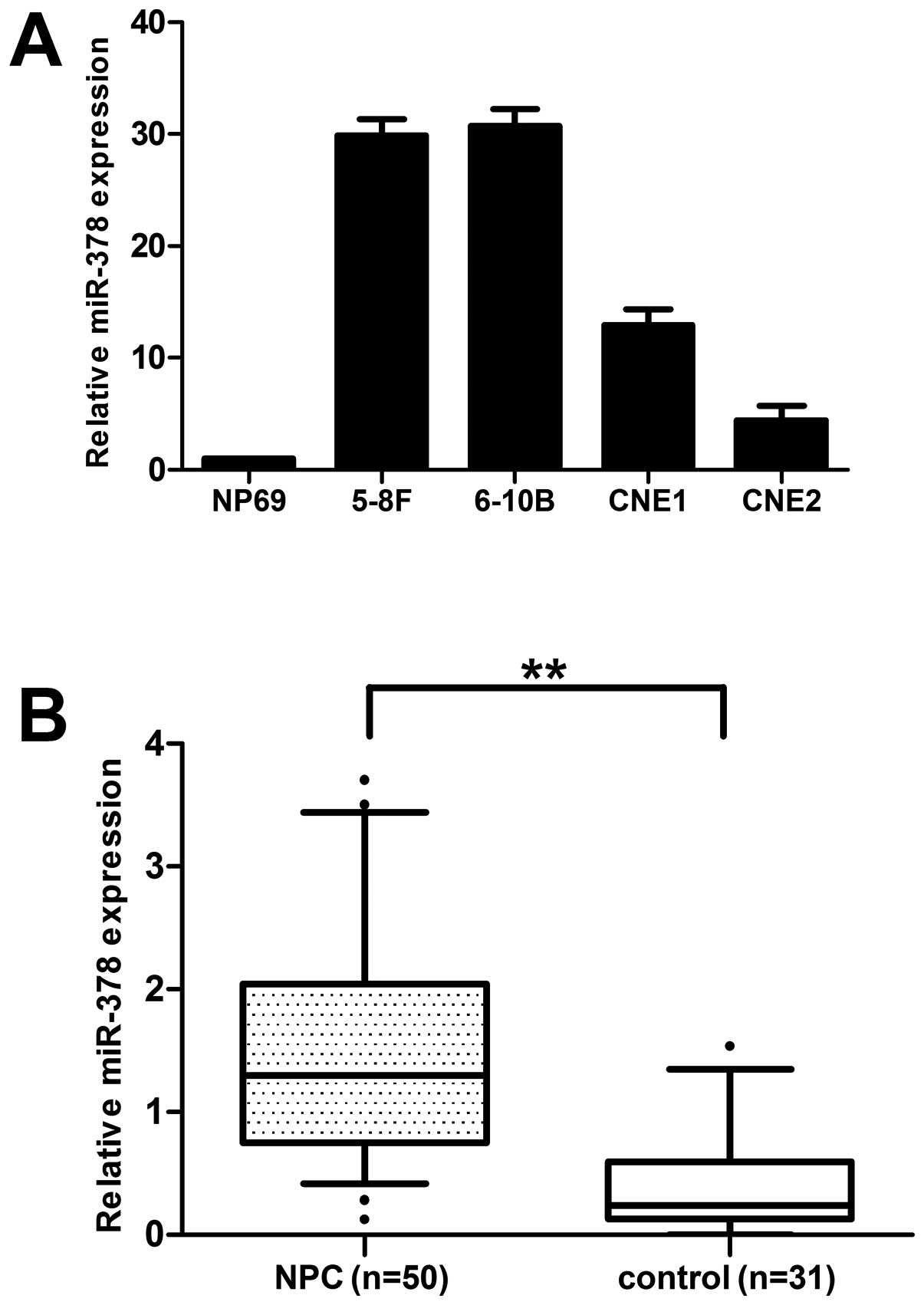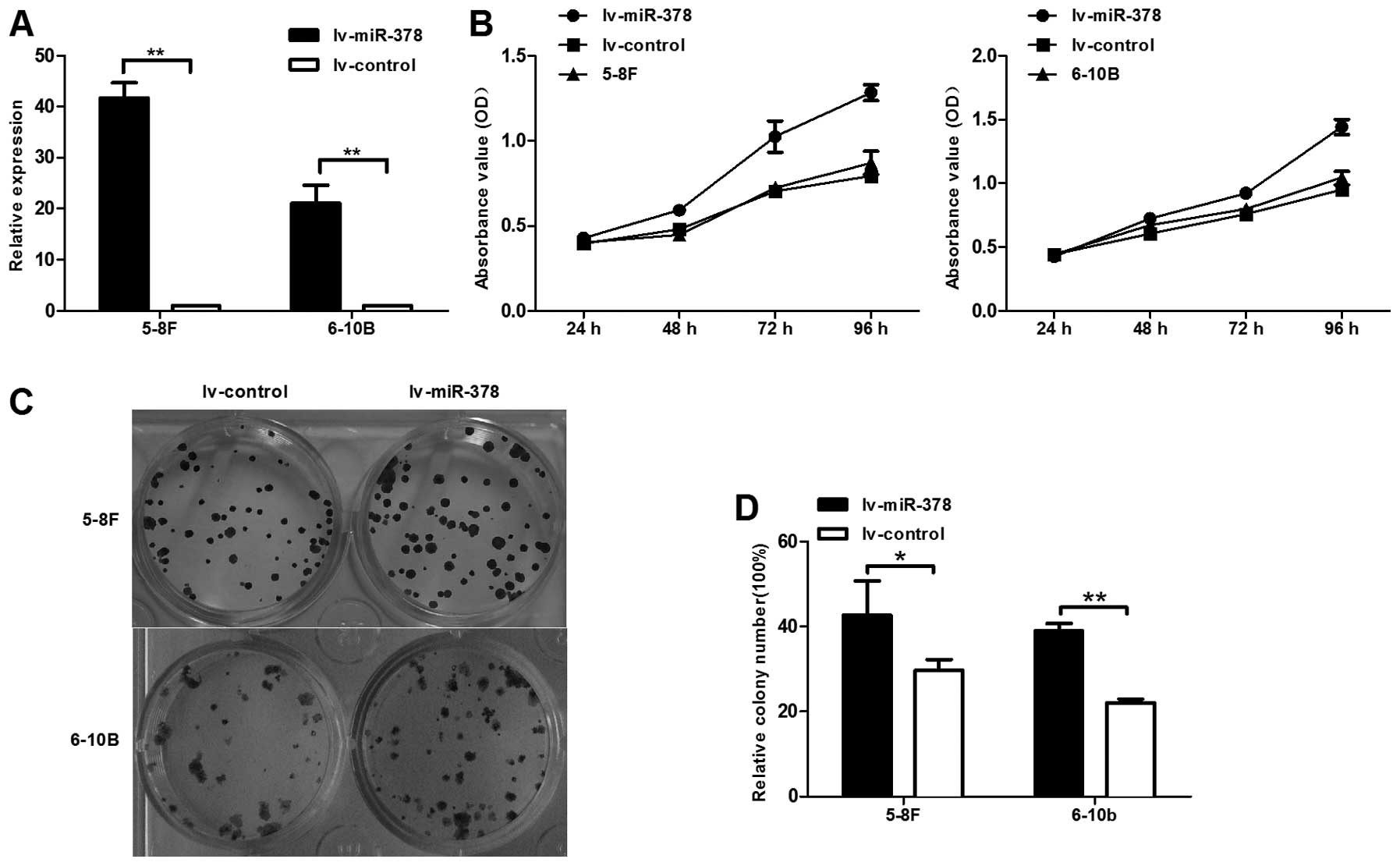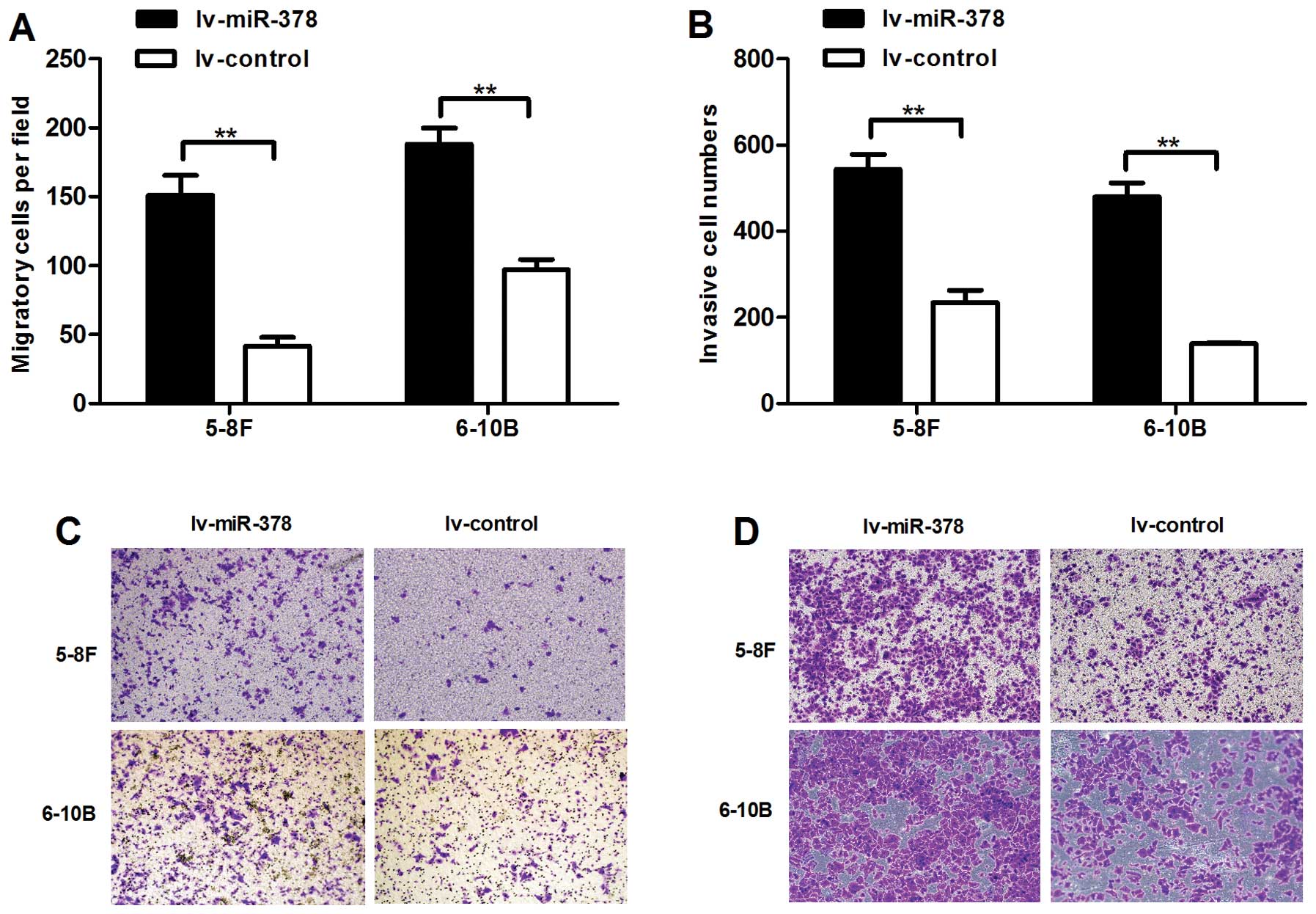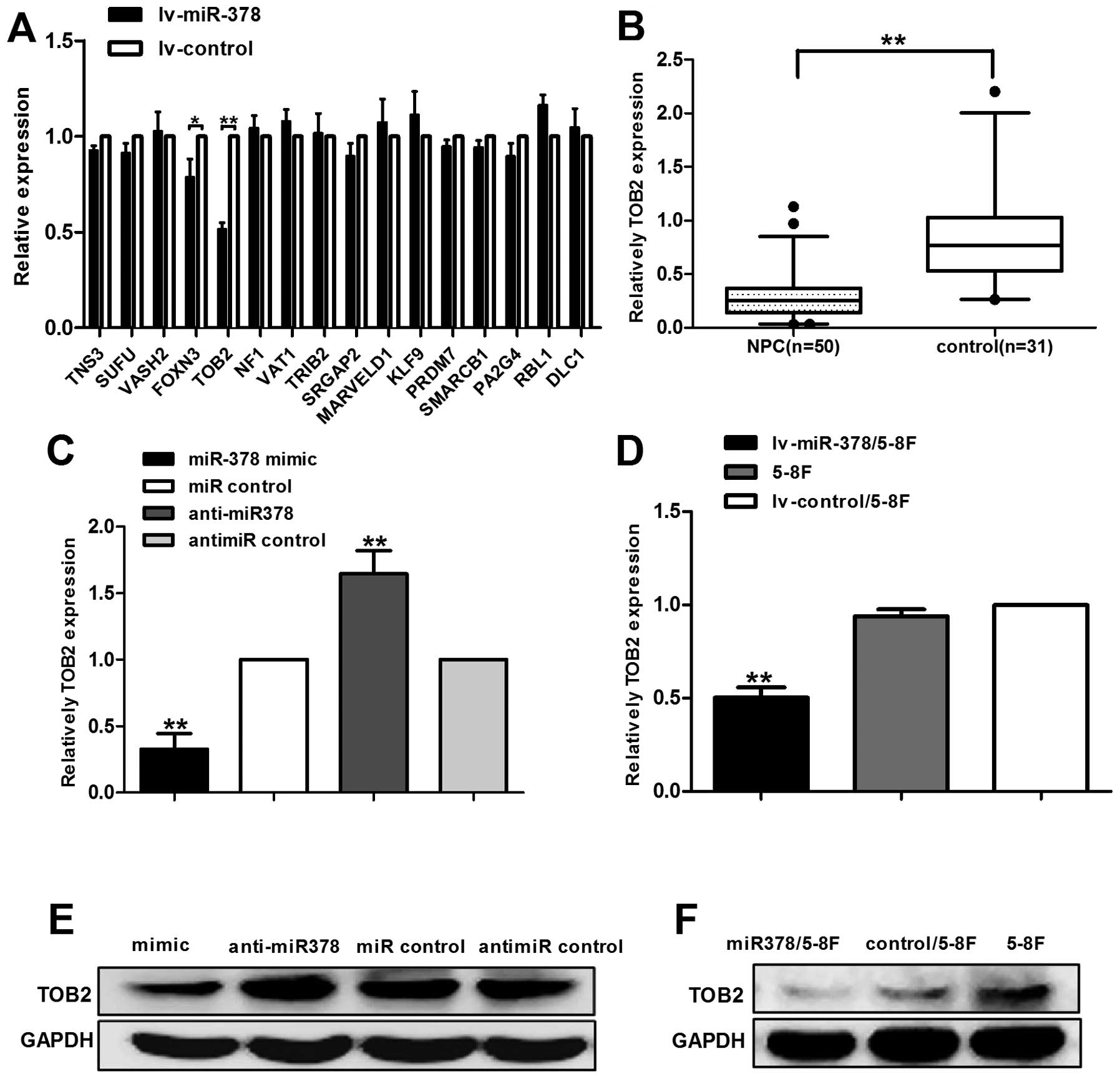|
1.
|
Wei WI and Sham JS: Nasopharyngeal
carcinoma. Lancet. 365:2041–2054. 2005. View Article : Google Scholar : PubMed/NCBI
|
|
2.
|
Heng DM, Wee J, Fong KW, et al: Prognostic
factors in 677 patients in Singapore with nondisseminated
nasopharyngeal carcinoma. Cancer. 86:1912–1920. 1999. View Article : Google Scholar : PubMed/NCBI
|
|
3.
|
Hong MH, Mai HQ, Min HQ, Ma J, Zhang EP
and Cui NJ: A comparison of the Chinese 1992 and fifth-edition
International Union Against Cancer staging systems for staging
nasopharyngeal carcinoma. Cancer. 89:242–247. 2000. View Article : Google Scholar
|
|
4.
|
Ma J, Mai HQ, Hong MH, et al: Is the 1997
AJCC staging system for nasopharyngeal carcinoma prognostically
useful for Chinese patient populations? Int J Radiat Oncol Biol
Phys. 50:1181–1189. 2001. View Article : Google Scholar : PubMed/NCBI
|
|
5.
|
Ameres SL and Zamore PD: Diversifying
microRNA sequence and function. Nat Rev Mol Cell Biol. 14:475–488.
2013. View
Article : Google Scholar : PubMed/NCBI
|
|
6.
|
Bartel DP: MicroRNAs: genomics,
biogenesis, mechanism, and function. Cell. 116:281–297. 2004.
View Article : Google Scholar : PubMed/NCBI
|
|
7.
|
Calin GA, Sevignani C, Dumitru CD, et al:
Human microRNA genes are frequently located at fragile sites and
genomic regions involved in cancers. Proc Natl Acad Sci USA.
101:2999–3004. 2004. View Article : Google Scholar : PubMed/NCBI
|
|
8.
|
Jansson MD and Lund AH: MicroRNA and
cancer. Mol Oncol. 6:590–610. 2012. View Article : Google Scholar
|
|
9.
|
Zhang B, Pan X, Cobb GP and Anderson TA:
microRNAs as oncogenes and tumor suppressors. Dev Biol. 302:1–12.
2007. View Article : Google Scholar
|
|
10.
|
Wiemer EAC: The role of microRNAs in
cancer: no small matter. Eur J Cancer. 43:1529–1544. 2007.
View Article : Google Scholar : PubMed/NCBI
|
|
11.
|
Sengupta S, den Boon JA, Chen IH, et al:
MicroRNA 29c is down-regulated in nasopharyngeal carcinomas,
up-regulating mRNAs encoding extracellular matrix proteins. Proc
Natl Acad Sci USA. 105:5874–5878. 2008. View Article : Google Scholar : PubMed/NCBI
|
|
12.
|
Yu L, Lu J, Zhang B, et al: miR-26a
inhibits invasion and metastasis of nasopharyngeal cancer by
targeting EZH2. Oncol Lett. 5:1223–1228. 2013.PubMed/NCBI
|
|
13.
|
Luo Z, Dai Y, Zhang L, et al: miR-18a
promotes malignant progression by impairing microRNA biogenesis in
nasopharyngeal carcinoma. Carcinogenesis. 34:415–425. 2013.
View Article : Google Scholar : PubMed/NCBI
|
|
14.
|
Liu Y, Cai H, Liu J, et al: A miR-151
binding site polymorphism in the 3′-untranslated region of the
cyclin E1 gene associated with nasopharyngeal carcinoma. Biochem
Biophys Res Commun. 432:660–665. 2013.PubMed/NCBI
|
|
15.
|
Li G, Liu Y, Su Z, et al: MicroRNA-324-3p
regulates nasopharyngeal carcinoma radioresistance by directly
targeting WNT2B. Eur J Cancer. Apr 10–2013.Epub ahead of print.
|
|
16.
|
Deng M, Ye Q, Qin Z, et al: miR-214
promotes tumorigenesis by targeting lactotransferrin in
nasopharyngeal carcinoma. Tumour Biol. 34:1793–1800. 2013.
View Article : Google Scholar : PubMed/NCBI
|
|
17.
|
Liu N, Chen N-Y, Cui R-X, et al:
Prognostic value of a microRNA signature in nasopharyngeal
carcinoma: a microRNA expression analysis. Lancet Oncol.
13:633–641. 2012. View Article : Google Scholar : PubMed/NCBI
|
|
18.
|
Liu X, Luo HN, Tian WD, et al: Diagnostic
and prognostic value of plasma microRNA deregulation in
nasopharyngeal carcinoma. Cancer Biol Ther. 14:Aug 23–2013.Epub
ahead of print.
|
|
19.
|
Jiang J, Lee EJ, Gusev Y and Schmittgen
TD: Real-time expression profiling of microRNA precursors in human
cancer cell lines. Nucleic Acids Res. 33:5394–5403. 2005.
View Article : Google Scholar : PubMed/NCBI
|
|
20.
|
Hua Z, Lv Q, Ye W, et al: MiRNA-directed
regulation of VEGF and other angiogenic factors under hypoxia. PLoS
One. 1:e1162006. View Article : Google Scholar : PubMed/NCBI
|
|
21.
|
Lee DY, Deng Z, Wang CH and Yang BB:
MicroRNA-378 promotes cell survival, tumor growth, and angiogenesis
by targeting SuFu and Fus-1 expression. Proc Natl Acad Sci USA.
104:20350–20355. 2007. View Article : Google Scholar : PubMed/NCBI
|
|
22.
|
Eichner LJ, Perry MC, Dufour CR, et al:
miR-378(*) mediates metabolic shift in breast cancer cells via the
PGC-1β/ERRγ transcriptional pathway. Cell Metab. 12:352–361.
2010.
|
|
23.
|
Faltejskova P, Svoboda M, Srutova K, et
al: Identification and functional screening of microRNAs highly
deregulated in colorectal cancer. J Cell Mol Med. 16:2655–2666.
2012. View Article : Google Scholar : PubMed/NCBI
|
|
24.
|
Qian J, Lin J, Qian W, et al:
Overexpression of miR-378 is frequent and may affect treatment
outcomes in patients with acute myeloid leukemia. Leuk Res.
37:765–768. 2013. View Article : Google Scholar : PubMed/NCBI
|
|
25.
|
Redova M, Poprach A, Nekvindova J, et al:
Circulating miR-378 and miR-451 in serum are potential biomarkers
for renal cell carcinoma. J Transl Med. 10:552012. View Article : Google Scholar : PubMed/NCBI
|
|
26.
|
Liu H, Zhu L, Liu B, et al: Genome-wide
microRNA profiles identify miR-378 as a serum biomarker for early
detection of gastric cancer. Cancer Lett. 316:196–203. 2012.
View Article : Google Scholar : PubMed/NCBI
|
|
27.
|
Yao Y, Suo AL, Li ZF, et al: MicroRNA
profiling of human gastric cancer. Mol Med Rep. 2:963–970.
2009.PubMed/NCBI
|
|
28.
|
Guo J, Miao Y, Xiao B, et al: Differential
expression of microRNA species in human gastric cancer versus
nontumorous tissues. J Gastroenterol Hepatol. 24:652–657. 2009.
View Article : Google Scholar : PubMed/NCBI
|
|
29.
|
Deng H, Guo Y, Song H, et al: MicroRNA-195
and microRNA-378 mediate tumor growth suppression by epigenetical
regulation in gastric cancer. Gene. 518:351–359. 2013. View Article : Google Scholar : PubMed/NCBI
|
|
30.
|
Chen LT, Xu SD, Xu H, Zhang JF, Ning JF
and Wang SF: MicroRNA-378 is associated with non-small cell lung
cancer brain metastasis by promoting cell migration, invasion and
tumor angiogenesis. Med Oncol. 29:1673–1680. 2012. View Article : Google Scholar : PubMed/NCBI
|
|
31.
|
Wu QP, Xie YZ, Deng Z, et al: Ergosterol
peroxide isolated from Ganoderma lucidum abolishes microRNA
miR-378-mediated tumor cells on chemoresistance. PLoS One.
7:e445792012.PubMed/NCBI
|
|
32.
|
Sand M, Skrygan M, Sand D, et al:
Expression of microRNAs in basal cell carcinoma. Br J Dermatol.
167:847–855. 2012. View Article : Google Scholar : PubMed/NCBI
|
|
33.
|
Sand M, Skrygan M, Georgas D, et al:
Microarray analysis of microRNA expression in cutaneous squamous
cell carcinoma. J Dermatol Sci. 68:119–126. 2012. View Article : Google Scholar : PubMed/NCBI
|
|
34.
|
Ambros V: The functions of animal
microRNAs. Nature. 431:350–355. 2004. View Article : Google Scholar : PubMed/NCBI
|
|
35.
|
Wang K, Zhang S, Marzolf B, et al:
Circulating microRNAs, potential biomarkers for drug-induced liver
injury. Proc Natl Acad Sci USA. 106:4402–4407. 2009. View Article : Google Scholar : PubMed/NCBI
|
|
36.
|
Tanaka M, Oikawa K, Takanashi M, et al:
Down-regulation of miR-92 in human plasma is a novel marker for
acute leukemia patients. PLoS One. 4:e55322009. View Article : Google Scholar : PubMed/NCBI
|
|
37.
|
Ikematsu N, Yoshida Y, Kawamura-Tsuzuku J,
et al: Tob2, a novel anti-proliferative Tob/BTG1 family member,
associates with a component of the CCR4 transcriptional regulatory
complex capable of binding cyclin-dependent kinases. Oncogene.
18:7432–7441. 1999. View Article : Google Scholar
|
|
38.
|
Suzuki T, K-Tsuzuku J, Ajima R, Nakamura
T, Yoshida Y and Yamamoto T: Phosphorylation of three regulatory
serines of Tob by Erk1 and Erk2 is required for Ras-mediated cell
proliferation and transformation. Genes Dev. 16:1356–1370. 2002.
View Article : Google Scholar : PubMed/NCBI
|
|
39.
|
Boiko AD, Porteous S, Razorenova OV,
Krivokrysenko VI, Williams BR and Gudkov AV: A systematic search
for downstream mediators of tumor suppressor function of p53
reveals a major role of BTG2 in suppression of Ras-induced
transformation. Genes Dev. 20:236–252. 2006. View Article : Google Scholar : PubMed/NCBI
|
|
40.
|
Winkler GS: The mammalian
anti-proliferative BTG/Tob protein family. J Cell Physiol.
222:66–72. 2010. View Article : Google Scholar : PubMed/NCBI
|
|
41.
|
Feng M, Li Z, Aau M, Wong CH, Yang X and
Yu Q: Myc/miR-378/TOB2/cyclin D1 functional module regulates
oncogenic transformation. Oncogene. 30:2242–2251. 2011. View Article : Google Scholar : PubMed/NCBI
|














